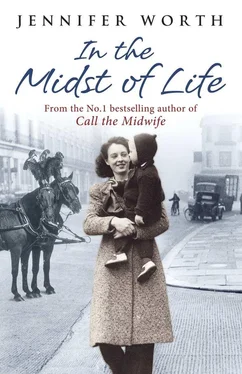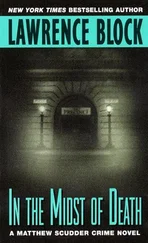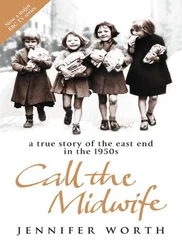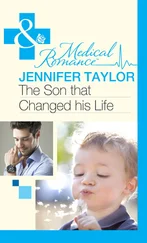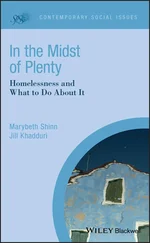Jennifer Worth - In the Midst of Life
Здесь есть возможность читать онлайн «Jennifer Worth - In the Midst of Life» весь текст электронной книги совершенно бесплатно (целиком полную версию без сокращений). В некоторых случаях можно слушать аудио, скачать через торрент в формате fb2 и присутствует краткое содержание. Жанр: Биографии и Мемуары, на английском языке. Описание произведения, (предисловие) а так же отзывы посетителей доступны на портале библиотеки ЛибКат.
- Название:In the Midst of Life
- Автор:
- Жанр:
- Год:неизвестен
- ISBN:нет данных
- Рейтинг книги:3 / 5. Голосов: 1
-
Избранное:Добавить в избранное
- Отзывы:
-
Ваша оценка:
- 60
- 1
- 2
- 3
- 4
- 5
In the Midst of Life: краткое содержание, описание и аннотация
Предлагаем к чтению аннотацию, описание, краткое содержание или предисловие (зависит от того, что написал сам автор книги «In the Midst of Life»). Если вы не нашли необходимую информацию о книге — напишите в комментариях, мы постараемся отыскать её.
In the Midst of Life — читать онлайн бесплатно полную книгу (весь текст) целиком
Ниже представлен текст книги, разбитый по страницам. Система сохранения места последней прочитанной страницы, позволяет с удобством читать онлайн бесплатно книгу «In the Midst of Life», без необходимости каждый раз заново искать на чём Вы остановились. Поставьте закладку, и сможете в любой момент перейти на страницу, на которой закончили чтение.
Интервал:
Закладка:
The family doctor had visited in the afternoon and given her a pain-killing injection. She had been sleeping peacefully ever since, but in the last hour her breathing had become increasingly worrying to him and she had begun twitching.
He couldn’t get hold of his doctor, and the GP surgery had redirected his enquiry to the out-of-hours doctors; they had simply instructed him to dial 999. That is how we ended up there.
We sat down and reassured the man. ‘We’ll phone the out-of-hours doctor back, ask for the palliative care nurses to come and be with you and get her some more pain relief so she isn’t in any pain.’ He was so grateful; you could see the tension lift from his face.
I made the phone call and explained the situation to the out-of-hours doctor, and said that we required a palliative visit. He refused point blank to attend and ordered me to take that poor dying lady from her nice warm bed to the accident and emergency department. I was nearly speechless, but attempted to reason with him that it was inhumane to suggest such a thing, the lady was dying and nothing we could do could halt the fact. He adamantly refused to consider it. He was the doctor, I was only the ambulance ‘driver’ and was not in a position to disobey his request. ‘Com-passionless’ was my thought, or maybe something stronger, I regret to admit.
How do you explain this to a distressed relative? That you have to drag his dying sister unceremoniously out of her deathbed and cart her off to the local accident and emergency centre, to be poked and prodded, and then breathe her last on a hospital trolley surrounded by the drunks and assaults that frequent A&E during the night shift? But he was understanding; we had no alternative but to obey medical orders.
We went and fetched our carrying chair, two big warmed blankets and a pillow to prop her up. I knelt on the bed behind her, and, as we lifted her into a semi-sitting position before settling her into the chair, she died.
I looked at my teammate and she nodded. We laid the woman straight back down in the bed, still warm from where we had lifted her up, smoothed her eyes over and covered her with the quilt.
I went to fetch her brother from the kitchen, and we all cried. How unprofessional, I hear you say! I knew in my heart it was the best thing for her. I phoned the out-of-hours doctor again, informing him that now the lady had died, he would have to visit and confirm death (in those days we did not perform recognition of life extinct).
Having personal experience as a relative also puts a whole new perspective on the whole end-of-life-care issue. This is something that I experienced for myself in 2008 when my own mother died from a chronic lung condition. It was the spiritual epiphany of this event that spurred me on to help our ambulance service develop a better insight into end-of-life care and how we can be of benefit to patients who are dying.
The death of my dear mother was, without a doubt, the most life-altering event of my existence.
She had a condition known as chronic obstructive pulmonary disease (COPD). She had lived with this for many years, but had been particularly unwell for the year preceding her death, and was being looked after mainly by the respiratory team at home where she had her own oxygen and nebulisers. She had suddenly been admitted to hospital with an exacerbation of the condition. The consultant told my elderly stepfather, Bernard, that there was nothing more they could do for her except ‘keep her comfortable’.
Mum was only sixty, and it was not until I went to visit her in hospital and saw her so ill that the terrible truth dawned on me that she was dying. I gathered the family round.
It was the most numbing and distressing thirty-six hours of my entire forty years. My brother Matthew (also a paramedic) rushed down from his home in East Anglia. We sat beside her all night and had some deeply intriguing conversations during those dark hours.
‘It’s quite ironic, isn’t it?’ mused Matt. ‘If either one of us received an emergency call to a patient of Mum’s age, who was unconscious and breathing like this, we would be intubating her, nebulising drugs, giving intravenous diuretics and rushing her into A&E as fast as we could.’
He had a point, and yet we sat there, helpless, while Mum’s breathing continued to bubble and struggle, the relentless dull sound of the oxygen hissing away, a constant background noise making my head spin. In the small hours of the night she grew distressed and started moaning and twitching. I went to find a nurse for some help. The doctor wrote her up for some morphine which the staff nurse administered. I asked her how long it would be; Mum’s vital signs were all over the place, her breathing and pulse rate were hugely elevated and her oxygen saturations very low. She had a raging temperature of 40.1.I wasn’t used to watching people die – I was meant to stop that sort of thing from happening. I was shivering on the little chair next to her, my hand tightly grasping hers, its heat keeping me warm in the depth of the night. Another doctor popped in to see Mum. I was beginning to panic.
‘I want to take her home to die,’ I stuttered.
‘It’s not an option now,’ replied the doctor. ‘I cannot discharge her like this, so close to death.’
It was a truly desperate feeling watching my mother dying, aching to swing into action and ‘do my paramedic stuff,’ when, deep inside, I knew there was absolutely nothing I could do to prevent the inevitable slide into death. Mum’s was as dignified as it could be in the little side room. Both Matthew and I held her hands and watched as her breathing slowly began to fail – when we were finally able to rid her of the oxygen mask – and saw the peaceful look come over her face when her exhausted heart eventually stopped beating.
It gave us both a whole new perspective on death and how it affects those it leaves behind.
We both returned to work, vowing to look into the end-of-life care policies our respective ambulance trusts had in place.
As a coincidence, in June 2008, the Darzi Report was issued by the Department of Health, with the title High Quality Care for All. Some of the concerns raised by Lord Darzi included those surrounding end-of-life care. I happened to glimpse some information on this review and begged my Chief Executive Paul Sutton to consider the possibility of championing end-of-life care for SECAMB NHS Trust. He was enthusiastic about my interest, and, with his encouragement, I attended a conference on the subject in November, and found it extremely engaging.
On the back of that conference – and by talking and writing to some of the speakers and delegates – I was invited to speak at the National Council for Palliative Care conference at Guy’s Hospital in March 2009 on the subject of ‘Dying Differently’. My intention was to speak to the delegates and impress on them the fact that ambulance crews are not just there to perform CPR and dash the patient to hospital, but we can also have a place with palliative care patients, even if it is just to administer pain relief or oxygen.
In the past year our Trust has implemented a general policy surrounding Do Not Attempt Resuscitation and Advance Directive to Refuse Treatment. Any palliative care team can email our Trust with a copy of these orders, and we have the facility to add a history marker linked to an address where a palliative care patient lives, so if an emergency call is generated for that person, the information is passed to the crew that the patient is not to be resuscitated.
Indeed, this facility also extends to GPs and hospital consultants who have patients who have requested DNAR for a variety of conditions – COPD (like my mother), advanced Alzheimer’s, Parkinson’s, or any other illness or condition where CPR is deemed inappropriate. The only thing we require to enable us to safeguard ourselves is the sight of the original unaltered document that is signed by the doctor on arrival at the call.
Читать дальшеИнтервал:
Закладка:
Похожие книги на «In the Midst of Life»
Представляем Вашему вниманию похожие книги на «In the Midst of Life» списком для выбора. Мы отобрали схожую по названию и смыслу литературу в надежде предоставить читателям больше вариантов отыскать новые, интересные, ещё непрочитанные произведения.
Обсуждение, отзывы о книге «In the Midst of Life» и просто собственные мнения читателей. Оставьте ваши комментарии, напишите, что Вы думаете о произведении, его смысле или главных героях. Укажите что конкретно понравилось, а что нет, и почему Вы так считаете.
